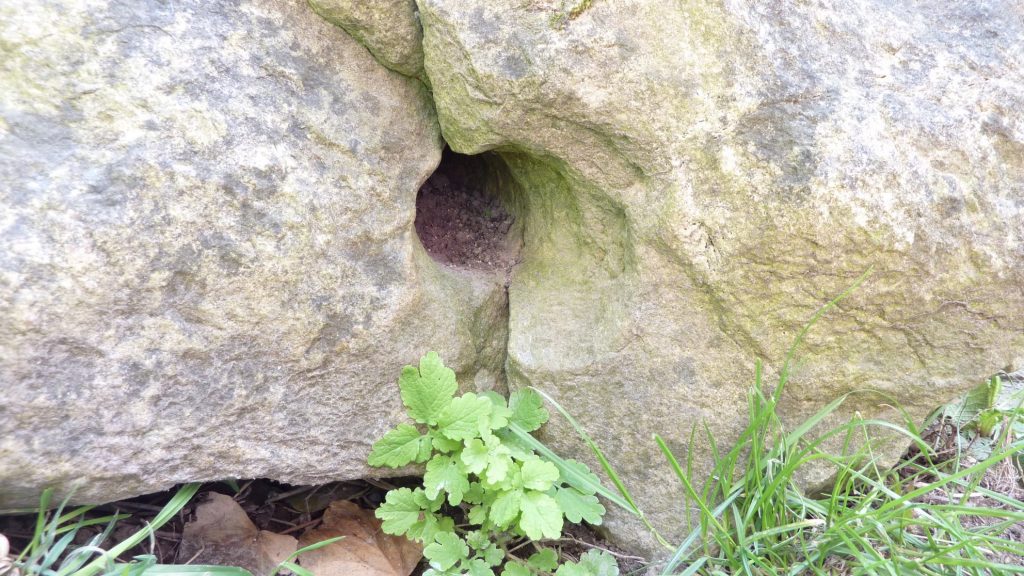Yesterday I drove out from Oxford to the Uffington white horse. On the way I stopped at the Blowing Stone, and blew it.

I can’t remember how I first found out about the blowing stone. I used to drive along the road from Wantage to the White Horse fairly regularly, and I may have seen the road name sign “Blowingstone Lane”, or the sign for the Blowingstone Inn in Kingston Lisle. I think I last visited the blowing stone over 15 years ago, and at that time I had a photo and I also made a little sound clip, which I put on my old website:
Though the sound quality is very poor, my old recording is being used by the English band Big Big Train for a track on their latest album, Folklore, due for release later this month.
The blowing stone is a fascinating thing, a natural lump of sarsen stone, as is found across this area, and as used for the building of the famous ancient temples of Stonehenge and Avebury. The sarsen stones are often pock-marked or holed, but the blowingstone is unique as far as I know, in that it has a natural hole right through it which can be blown like a horn or trumpet.

You can see how there are a number of other holes in the stone which don’t connect through, and you can also see that there is a lot of use-wear around the mouthpiece area.

The natural bore exits near to the ground; I believe the passage divides in two and exits in two “bells”.
The blowingstone appears to be entirely natural and unworked, and so it is ancient in human terms, having been formed in geological time along with the chalk and flint of this landscape. However it is an enigma how old it is as a musical instrument. The pamphlet available for sale in the tiny honesty box beside the stone, (L.V. Grinsell, The Blowing Stone, 1993) suggests two possible histories of the stone – that its use dates back to the time of King Alfred (late 9th century), or that it was first discovered in the 18th century. I would think that an archaeological investigation of the stone, including use-wear analysis and scientific dating of the exposed surfaces, might offer clues as to how long it has stood above ground.
Grinsell says “The interest of the stone is botanical and geological rather than archaeological”, but for me the primary interest is organological. I am still wondering what methods one might use to generate an accurate 3D model of the bore profile of this instrument.
The Bleawin Stwun in days gone by Wur King Alfred's bugle harn,
from ‘The Ballad of the Scouring of the White Horse’, in Thomas Hughes, The Scouring of the White Horse, 1859. Online at archive.org

The traditions recorded in the 19th and early 20th century suggest it originally stood on the downs above, to the south, i.e. on the Ridgeway, or perhaps even along at Uffington Castle, the iron-age hillfort next to the white horse. Is it too much to imagine that the stone’s musical properties were already known and used then, over 2000 years ago? I like to think so.
And what about the megalith engineers who searched all over this landscape for sarsens to transport to Avebury and Stonehenge to build the great stone circles and chambered tombs over 2000 years earlier? Would they have seen it, and noticed the hole through its middle?

This is absolutely fascinating. Thank you so much for posting and demonstrating. We just found out about this tonight, and are amazed.
Thanks again
Lee & Pat
New Jersey usa
In my early teens (in the mid 1960s) I used to frequently cycle to the White Horse Hill and Dragon Hill during the weekends or school holidays, and return home via the Blowing Stone, through Kingston Lisle, Charnet Bassett and Abingdon to my house just north of the town. It was about an hour and a half of pedaling on flat ground to get home after descending from the high ground of the Ridgeway. Never did get a decent sound out of the Blowing Stone though, despite several attempts over the years. Happy days.
Yes learning trumpet at school gave me an unfair advantage! Thanks for your reminiscences.
As children we often visited the blowing stone after a picnic on Dragon Hill. A lady would come out from her cottage, wipe the stone and allow you to blow. My brother could get a good sound but I never managed much of a sound.
Thank you Jill for your memories… How long ago would this have been do you think?
Hi everyone, last time I was at the blowing stone was in 1954, cycled there with my father and younger sister. I was 11 years old. We tried to blow it- no success. Afterwards we walked the cycles up the hill to the White Horse, stood on its head and eye, walked down its back- days of innocence and no responsibilities, and butterflies everywhere.
Thank you Roger for remembering this. Sounds wonderful.